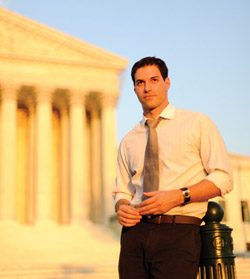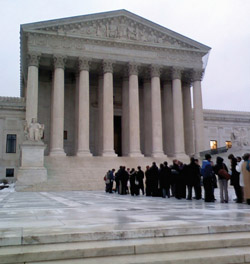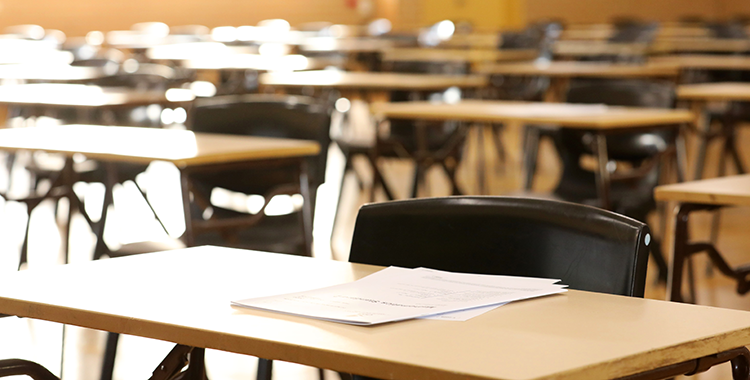By Dawn's Light

Photo by Cameron Davidson
My name is Mike Sacks. I am a third-year law student at Georgetown interested in legal journalism and the intersection of law and politics. This semester, I have no morning classes. As such, I will be taking advantage of living only minutes from the Supreme Court to pursue a rather unorthodox extracurricular activity: reporting from the court as the first one in line at 1 First St.
I wrote that in a fit of inspiration late one night last December. And just like that, I became the author of the blog First One @ One First. That is, I am a reporter who, for a semester of law school, took his view of the U.S. Supreme Court from the public line that forms in the early morning hours on the days of important oral arguments. I went outside to explore the opinions of those who cared enough about an issue to stand there in a freezing predawn to assure themselves a seat to hear a newsworthy case. That was the theory, at least.
From my first morning on Jan. 11 until my final overnight on June 27, I witnessed relationships and communities being formed among men and women whose personal engagement with the American system of government transcended their political differences.
I wasn’t always first in line, despite my aspirational title (I was six for 10, for the record), but whether I was first in line, second, third, fifth or 34th, I found all around me new friends cutting through the cold by the warmth of each other’s company.
In January, there were Jim and Meade Klingensmith, the toweringly tall father and son from Pittsburgh who sauntered into line on every argument morning for the entire two-week sitting. Meade was a sophomore at Oberlin College pursuing an independent study in which he was observing the court in action and then predicting its decision in each case. Jim, Meade’s dad, had a big grin each morning, thrilled to have these mornings to bond with his boy, even if it meant they had to wake up at 4 a.m. for half the week to do so.
In February, scores of black firefighters from Chicago came out to see justice served in Lewis v. City of Chicago, a disparate-impact case that was decided in their favor by a unanimous vote several months later. Among the attendees was Jim Winbush, a retired firefighter who founded the African American Firefighter’s League of Chicago in 1968 to fight for greater equality in a newly integrated fire department charged with putting out the fires that had raged through the city during that summer’s race riots. Arriving in line before dawn, Win bush talked until the sun came up about his more color ful days on the job, attracting an ever-expanding crowd of amused listeners.
With March came McDonald v. City of Chicago, the court’s Second Amendment sequel to 2008’s District of Columbia v. Heller; which established in federal jurisdictions the individual right to keep and bear arms for purposes of self-defense. McDonald asked whether Heller should be applied to state and local gun control efforts, and brought more talk about the 14th Amendment’s privileges or immunities clause than you’d find in an entire semester’s constitutional law seminar. And those leading the discussion weren’t lawyers or law students; they were chemists from Malibu, Calif., and military vets from Connecticut and Texas.
For some reason, late April seemed no warmer than early March. And outside the court on the eve of Christian Legal Society v. Martinez, I sat surrounded—with students from CLS chapters across the country on one side of me and a same-sex couple on the other, all huddling together to keep each other from freezing. The question to be considered by the court the next morning was whether the University of California’s Hastings College of the Law violated First Amendment rights of association and free exercise of religion by refusing to recognize and fund CLS as an official campus organization because of its policy barring gays and lesbians from serving as officers.
To hear oral arguments on these issues was our reason to be there in the first place, and there were turned heads and giddy giggles from even the most grizzled of my cohorts as they climbed the steps to enter the building. It was hard not to be awestruck walking the Great Hall with the busts of every chief justice staring at you through their marble, iris-less eyes, as you make your way toward the courtroom. And there’s nothing quite like the payoff of taking your seat inside the courtroom, between the massive stone pillars, after waiting all night to get there. The 30 minutes between that moment and the emergence of the justices to the marshal’s “Oyez, oyez, oyez” are so filled with a sense of anticipation that the hours outside seem like seconds by comparison.
But as inspiring as that is, there were nights on the line when we could be just as awed by the way the line itself could connect even the most remote corners of the body politic.

HIGH COURT STAKEOUT: Some who wait to enter the Supreme Court are lawyers, some have a stake in a case to be heard, and some are citizens who simply want to be there. Photo by Mike Sacks.
We make a big deal about sleeping on a sidewalk for a night. But for us, it’s a choice. The vast majority of those in line were lawyers and law students. Others were professionals whose work might be impacted by the case at hand. Our “hobo gear” consisted of clean fleeces and jackets purchased at sporting goods stores or gifted to us by family. And on the mall, around the Capitol grounds and before the court, we were often the only ones sans shelter into the morning.
The scene changes a few blocks north, a mile east, a westward bus ride downtown. Men and women huddle in their fifth-hand sleeping bags at the McPherson Square metro stop, just a few hundred yards from the White House. Northwest, up 16th Street, they sleep on benches in Meridian Hill Park, overlooked by old society high-rises now populated with young professionals. If they’re lucky, they get a bed for a night in the shelter across the street from Georgetown Law.
In this city so crammed with law and politics, it never occurs to us that the homeless, too, may be invested in the system that seems to have no room for them. Sure, every once in a while as I walk past the Capitol on my way to class, there will be a man in tattered clothes holding an anti-tax protest sign that someone paid him to parade for the day. But not once in my many waits outside the court had the line been confronted with a single exposure to homelessness beyond our own assuredly temporary tailgates.
One particular night in February, a woman with close-cropped hair wearing stained sweats and ramshackle shoes walked up and asked what our line was for. We told her that we were in the general public line for the next day’s case.
“The general republic line, huh?” she responded. “You need ID for this? I don’t have ID. I just have my birth certificate.” No ID necessary, we told her. The court is open to the public. “The U.S. Supreme Court?” she asked. Right behind us, we replied. “You gonna be here all night?” she asked. We told her we would be. She then went on her way toward Union Station, where she could seek shelter from the cold night air.
As the sun came up and the police officer led our migration from the sidewalk to the plaza, there stood the woman beside a tall, blond man wearing a suit, both staring in awe at the court and quietly discussing what we were all about to witness.
Once seated inside, I looked across the courtroom to find that this woman somehow scored an aisle seat in the middle of the reserved section. For the next hour, while the justices listened to an argument over whether petition-signers had a right to keep their names and addresses private to the general public, there sat a woman without an address, nameless spare the birth certificate she carries in her pocket, silently making a statement inside our nation’s highest court that she counted.
A few of us in line had cast sideways glances at each other when she heard “general republic” out of our “general public” the night before. But as we exited the court on its last day of oral arguments for the term, we realized that she’d actually had it right.
Mike Sacks chronicled his experience in line and in court with posts at ABAJournal.com. Read his columns here:
February 22, 2010: In Lewis, the Court Stops, Drops and Rolls Over Chicago
February 23, 2010: Today at SCOTUS: Mohammed Atta & His Harmonica Quartet
February 26, 2010: Vox Populi: The Lewis Line
March 2, 2010: First One @ One First: There Will Be Blood
March 4, 2010: First One @ One First: The Line Doesn’t Lie
April 19, 2010: First One @ One First: A Gift for Justice Stevens
April 20, 2010: First One @ One First: Fortune from Miscalculation
April 27, 2010: First One @ One First: Into the Weeds
April 28, 2010: First One @ One First: Justice Stevens’ Valedictory Question
April 30, 2010: Vox Populi: The General Republic
July 1, 2010: It’s Time to Watch the Justices’ Real Life – on Real TV
Mike Sacks expects to graduate from Georgetown Law School in December.



